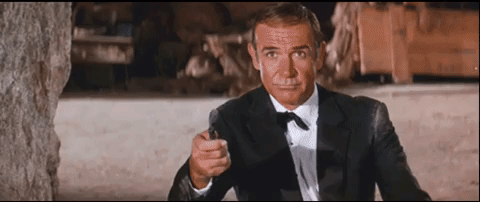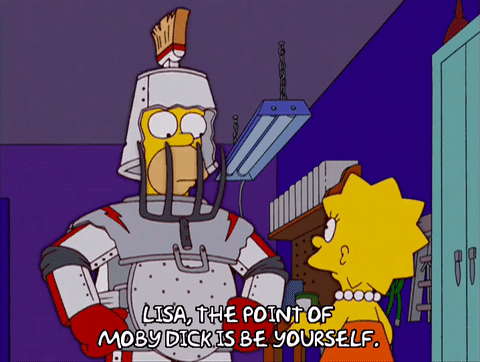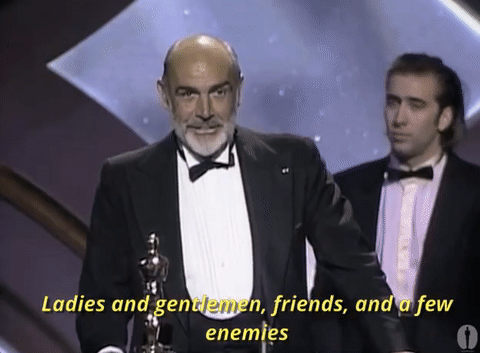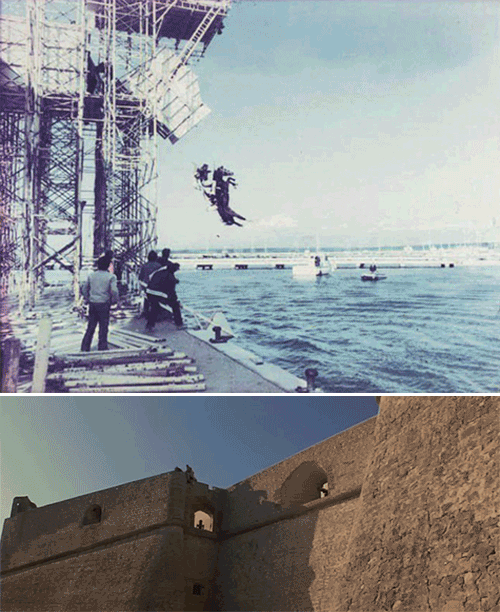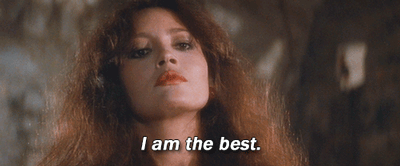Listen to the companion Raven Bond podcast here!
Released: October 1983
Producer: Jack Schwartzman
Director: Irvin Kershner
Written by: Lorenzo Semple Jr (Dick Clement and Ian Le Frenais uncredited) based on a story by Kevin McClory, Jack Whittingham and Ian Fleming
Plot:
After failing a skills test in the field, James Bond is sent to a health retreat to get in shape via a regime of colonics. But that’s not the only shit going down, as Bond stumbles upon a mysterious man recovering from an eye operation. Bond starts to join the dots once a US jet carrying two nuclear warheads is stolen, forcing a very grumpy M to reactivate the Double-O section and send Bond on the trail of the terrorists. Bond journeys from Nassau to Paris to North Africa and the Persian Gulf on the tail of Maximillian Largo, a millionaire weirdo with a penchant for video games and two-way mirrors.
Famous For:
Kevin McClory’s long-awaited version of Thunderball
The return of Sean Connery to the Bond role
Kim Basinger’s breakthrough role
THAT G-BANGER
If nothing else, Never Say Never Again stands as testament to one man’s relentless pursuit of a cinematic white whale.
Instead of Moby Dick we have the plot of Thunderball. Instead of Captain Ahab we have Kevin McClory, the Irish screenwriter and producer who would spend more than half of his life chasing his Double-O-Seven dream.
Strangely enough, McClory served as assistant director to John Huston on his 1956 adaptation of the Herman Melville classic.
And he was predisposed to hang on for grim death. During World War 2, he’d survived two weeks at sea in a life raft after the Norwegian tanker he was working on was torpedoed by U-boats. When McClory and other survivors were rescued 600 miles away off the coast of Ireland, his frostbite was so severe he lost the ability to speak for a year after being rescued.
Having lost his voice once, he was clearly never going to be shut up again.
And so when Ian Fleming released the novelisation of Thunderball - the story of which he and fellow writer Jack Whittingham had conceived with Fleming in 1958 as part of a deal to bring Bond to the big screen, pre-Eon Productions - McClory never forgot, and wouldn’t let anyone else forget either.
From the time of Fleming’s backstabbing, through decades of legal action, the eventual production of Never Say Never Again and beyond, McClory would never shut up about his part in the Bond legacy.
Never Say Never Again is a retelling of the Thunderball story, with many key characters retained or only slightly altered, with the added twist that Bond is now an elder statesman of MI6 to explain Sean Connery’s presence.
The film’s title came courtesy of Connery’s wife Micheline, who reminded everyone that’s what he had said after hanging up the tux with Diamonds Are Forever. It’s suitably naff, and a darn sight better than some of the alternatives such as “James Bond of the Secret Service” or “Warhead”.
But why was Connery there in the first place?
McClory had been credited as producer on Thunderball after protracted legal wrangling prevented it from being turned into an Eon movie before 1965. He settled with Eon on the condition that he not attempt to make another version for 10 years after Thunderball’s release.
Of course, once 1975 rolled around, McClory started plotting another version, and brought Sean Connery in as a script consultant. It’s hard to find detail as to Connery’s motivation, but given he was barely on speaking terms with Cubby Broccoli and Harry Saltzman by the end of You Only Live Twice, and only did Diamonds Are Forever if he was spared too much dealing with the producers, one wonders if spite might have played a role.
No doubt money helped too; Connery wasn’t initially planning to play Bond again, but was convinced by producer Jack Schwarzman, who probably realised the commercial value of a Connery return. Certainly Connery realised the value of the $3 million pay cheque plus percentage of the gross.
Plans to put the film up against Moonraker fell through, and with hindsight that was a lucky break. There’s no way nuclear warheads could compete with space battles and lasers of the late 70s.
Against Octopussy though, it makes for a far better contender (not that they’d know it at the time). The prospect of The Battle of the Bonds in 1983 scared Eon Productions enough to launch further legal action (which they lost), and to back the dumptruck full of cash up to Roger Moore’s house, convinced that despite his age he was the only one capable of defeating a returning Connery at the box office.
Indeed, Octopussy did do better sales than Never Say Never Again, but only by $25 million. It was technically a win, but it also prompted Eon to stay with Moore for a victory lap in A View to a Kill, which was arguably not to its advantage.
But what of Never Say Never Again itself?
It’s messy, for sure, particularly with its dashing around the UK, Caribbean, North Africa and Persian Gulf.
Nassau was the key location for Thunderball, where the warheads were stolen and hidden, and where all the action takes place.
In Never Say Never Again, Bond heads to the Bahaman capital also seemingly on the trail of Largo’s superyacht the Flying Saucer (not a patch on the Italian translation “Disco Volante”!). But it’s Rowan Atkinson’s diplomat character, Nigel Small-Fawcett, who discovers offscreen that it has sailed on to Paris relatively quickly.
The whole sequence could have been covered by a quick phone call back to Blighty - the only probing Bond actually does is of Fatima Blush’s impeccably waxed body in a weird sex scene/fish montage.
Max Von Sydow is impressive as the unnamed Blofeld (complete with signifier cat), but underused.
Thunderball’s deadline for setting the bombs off did stretch, but at least it contained the ringing of Big Ben to indicate NATO was willing to pay the ransom. This group of evil villains - who we assume is the SPECTRE leadership team - don’t seem fussed about actually getting money, or indeed when the first bomb is found and deactivated. They’re seen in full party mode as it approaches time for Largo to set off the second warhead. So they just… didn’t care about the money? Is it something to do with the oil fields being targeted? Do they have stocks in non-Middle Eastern oil? Is it a bit unclear?
The “Tears of Allah” necklace is a blisteringly silly MacGuffin. Largo gives it to Domino claiming it’s the most precious thing he owns, and we realise later this is because it contains a map to where one of the bombs is concealed. We rarely see Domino actually wearing it, but somehow she has it on her after she and Bond escape Largo’s Palmyra estate/prison. It exists so Bond can find the final hiding place; but it makes no sense why Largo would have it made and give it to Domino. He clearly doesn’t trust her - hence monitoring her onboard dance classes via two-way mirror - and what’s the point of risking discovery when he’s clearly memorised the location anyway?
When Domino does betray Largo, his punishment is to auction her off to passing Arabs. It’s clearly not the most politically correct scenario, and it’s somewhat easy to forget considering when Bond escapes his prison cell and rescues her on horseback, they proceed to getaway by JUMPING THE HORSE INTO THE FUCKING SEA:
Given the brazen audacity of such a shot, a 2020 viewer automatically assumes that MUST have been trick photography or fancy editing… mustn’t it?
This behind the scenes shot indicates that it most definitely was not:
Apparently the moment when the poor pony and Connery and Basinger’s stunt doubles smack into the water is always cut for British TV screenings of the film - you can see a version of that here.
The filmmakers were careful to insert a shot of a horse swimming away, seemingly fine, but was it the same horse as used in the stunt? We probably shouldn’t think too much about it, less the horse haunts our dreams, like a train in the night, like a train in the night.
What the film does better than Thunderball is excise a number of underwater sequences, and reduce the total amount of time spent in face-obscuring scuba gear. Don’t get me wrong, they’re still there, but they do seem less obtrusive.
Bond has a great scene trying to escape from some mind-controlled sharks Fatima Blush sets on him, and Domino’s final felling of Max Largo still happens with a harpoon, but only this time she’s joined Felix Leiter and followed Bond underwater to confront her creepy ex (Special mention to Bernie Casey as Leiter, the first time an African-American man had been cast in the role, and a great choice).
The way the film addresses age and change is generally handled pretty well. Bond’s time at Shrublands (keeping the same weirdly basic name as Thunderball) is defined by his refusal to drop trou for cleansing colonics and instead feast on smuggled caviar, fois gras and vodka like he has the liver of a 20-year-old. He’s also confronted by the thug Lippe when he starts investigating Fatima Blush and her charge, and only defeats him by splashing him in the face with… a sample of his own urine.
I both love this and detest this.
Bond is suitably sceptical of his grouchy, by-the-numbers new M, who seems to have a kink for dressing down Double-O-Seven. He also has a telling encounter with Algernon, a “Q” Bond seems to know well, even if we’ve never heard of him. Sniffling in a freezing laboratory, Algie moans in his Cockney accent about how the bean counters are in charge, the budgets are being cut, and if only the CIA would hire him with its deep pockets. There’s possibly a commentary there on Thatcher’s Britain, although you would hardly think the Iron Lady would want to scrimp on security.
Connery’s cheekiness retains a certain charm, even if his strangely-tinted hairpiece seems to be working as actively against him as any double agent.Playing up the “youth versus experience” angle with Connery and Klaus Maria Brandauer’s Largo is a great reversal of the roles from the original Thunderball. This vibe is best captured by the casino sequence, in which Brandauer challenges Bond to a game of Domination, a high-tech interactive shooting game in which losses are translated to real electrical shocks.
Bond claims one dance with Domino for defeating Largo at his own game, and it’s rather spectacular to see Bond tango like he’s been rehearsing for Dancing with the Stars. We’ve only ever seen Bond slow dance before, so even though one would expect Bond to be as good with vertical movement as he is with horizontal, it’s still strange to see him go full choreo.
It is, however, quite a master stroke to have him break the news to Domino about her brother’s death (he was the Shrublands patient who’d had his right cornea replaced to resemble the US President’s so he could switch out dummy warheads for real ones, because plot) midway through the dance. Given how closely Domino was watched, it was a clever way of telling her in plain sight, and literally being a physical support. Domino is shown from the start to be a dancer, so is able to discipline her rage and grief through her body. It’s Basinger’s best moment in the film, in a part that she does her best with, but does not give her huge scope for nuance.
The person who walks away with this film is Barbara Carrera as Fatima Blush.
A somewhat enigmatic Nicaraguan American model and actor, Carrera turned down the titular role in Octopussy to play SPECTRE agent Fatima Blush. It was a good choice because she is splendid here; chewing the scenery like a puppy with a smelly shoe, but never letting her high camp strut descend into farce.
Blush is dressed in the most outrageous 80s designer outfits; barely a scene goes by without a costume change. God knows how agile she could be as an enemy agent with a wardrobe that big, but she manages, because…
The costume designers on this film deserve particular credit, as every sartorial detail for Blush is on point. Carrera too makes a magic choice, keeping Blush’s hair slick and polished until she is given permission to kill, which allows her to let down her mad curls in preparation for passionate murder.
There’s SO MUCH going on with this ensemble, but it all clicks.
Pretty much everything Fatima Blush does is batshit crazy, but it all works: throwing a snake into a car to cause a crash, then blowing the car up anyway; fucking Bond at sea before attempting to feed him to the sharks rather than just shoot him; blowing up Bond’s hotel room in a totally non-subtle way (only to be foiled by Bond getting it on with another lady in her room at the time).
When she thinks she’s got Bond by the short and curlies, she makes him sign a piece of paper stating she was his best ever lover. This gives Bond the chance to shoot her with his Union flag-patterned exploding dart pen, which blows Fatima Blush to kingdom come. All that’s left are her four-inch stiletto heels. Of course, the only way she could be stopped was by total incineration. She was too badass for anything less.
I am actually surprised Carrera’s performance is not more well known as a cult classic - likely because the movie as a whole is not that way inclined. But Carrera is, as the kids would say, “iconic” in this role, and to me, the reason I’m glad Never Say Never Again exists. She should be celebrated for portraying this supremely confident, gives-no-fucks, clever but deranged agent provocateur.
Never Say Never Again was directed by Irvin Kershner, whose immediate past project was helming, of all things, The Empire Strikes Back. The fight co-ordinator was, of all people, soon-to-be action star Steven Seagal.
This guy.
Production was troubled, with producer Jack Schwartzman seen by Connery as inexperienced, and whom resorted to paying for things out of his own pocket due to budget overruns.
Still, by the end of 1983, Kevin McClory finally had his own film, and it was received well enough by both critics and fans.
It wasn’t enough to fill the white whale-shaped hole in McClory’s heart though - he would go on to try to remake the story AGAIN in the late 80s, with differing accounts suggesting he’d offered the Bond role to Pierce Brosnan (before he’d got it) and Timothy Dalton (after he left it).
It never happened, and eventually MGM bought up the rights to Never Say Never Again from Schwartzman’s own company. So while it it technically isn’t a Bond film, its TV and distribution rights are managed by the same parent company. Perhaps it’s now the strange cousin, quietly let into the family reunion.
Finally done with the Bond role, Connery would now enter the “distinguished” phase of his career, playing grizzled tough guys such as Ramirez in Highlander, Jimmy Malone in The Untouchables (for which Connery won an Oscar), and Ramius in The Hunt for Red October. He had a comic turn as Henry Jones Senior in Indiana Jones and the Last Crusade, and would carry on to play anti-heroes in The Rock and Entrapment, before turning down Gandalf and starring in the critical disappointment The League of Extraordinary Gentlemen.
However because this is my retrospective essay, and I can, I would just like to point you in the direction of Connery’s Greatest Ever Uncredited Cameo, in one of my favourite films (no arguments please) Robin Hood: Prince of Thieves.
McClory died on 20 November 2006, four days after Casino Royale was released in British cinemas.
Having harpooned the white whale Thunderball back in ‘58, McClory let himself be dragged by that sucker for almost half a century. Even when he’d achieved his goal, and had his name on Never Say Never Again, he still wasn’t satisfied.
One wonders what he would think of his family eventually selling his rights to SPECTRE, Blofeld and all associated stories and characters back to Eon, allowing the 2015 film SPECTRE to feature the villainous organisation for the first time since On Her Majesty’s Secret Service? Would he be cool with it? Or…
I couldn’t find a Gregory Peck GIF, so you get Khan instead.
Thank you for reading this instalment of the James Bond Retrospective! If you enjoyed it, you can sign up to support the series and my other writing/podcasting efforts via my Patreon page. Thanks to all of you who are already members; your support is truly invaluable.
You can listen to the companion Raven Bond Never Say Never Again podcast here:
Stu and I have are also ranking the Bond films as we watch and podcast about them. Here’s how we stand:
Join us next time as we return to Eon and Roger Moore’s final bow - A View to a Kill!
